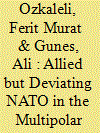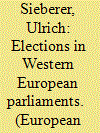|
|
|
Sort Order |
|
|
|
Items / Page
|
|
|
|
|
|
|
| Srl | Item |
| 1 |
ID:
184667


|
|
|
|
|
| Summary/Abstract |
“How long can NATO last in a post-US hegemonic, multipolar world?” has become an important question in contemporary world politics. By statistically analyzing NATO alliance cohesion since its inception, this analysis contributes to the literature by developing an original set of indicators that rely on the ideal point estimates from a recent UN General Assembly voting dataset. It empirically verifies that NATO members have higher cohesion than other UN members, although the United States has been the most significant deviating member since 1980. The findings support some earlier proposals such as the external threat hypothesis. They also contradict some others, notably the literature on the Donald Trump administration’s withdrawal doctrine, and the decline of US hegemony and its policy implications. The article concludes that the future challenge for NATO cohesion not only would be the possibility of US abdication or abandonment, but also other members’ balancing the United States as the hegemon.
|
|
|
|
|
|
|
|
|
|
|
|
|
|
|
|
| 2 |
ID:
182554


|
|
|
|
|
| Summary/Abstract |
This paper presents new evidence on the effects of neighbors and allies on defense burdens using a spatial econometrics model with panel data on 36 countries in Europe collected over 19 years. Apart from the conventional spatial matrices of geographical neighbors, we develop special political vicinity matrices based on arms transfers, which reveal political closeness among countries, and solve the problems associated with endogenous weight matrices by using a QMLE approach. The regression results demonstrate that the defense burden is positively and spatially correlated among geographical neighbors. The use of political vicinity matrices reveals a negative effect of allied relations on defense burdens, which supports the free-riding theory in alliances for setting a defense budget. With composite matrices, the intimidation effect induced by geographical approaches is dominated by the free-riding actions of allies, and the effect becomes more pronounced over time.
|
|
|
|
|
|
|
|
|
|
|
|
|
|
|
|
| 3 |
ID:
120510


|
|
|
|
|
| Publication |
2013.
|
| Summary/Abstract |
Parliaments often elect holders of important extra-parliamentary offices such as heads of state, constitutional judges, heads of audit institutions and ombudsmen. What drives the behaviour of parliamentary actors and the outcome of such elections? This article explains actor behaviour theoretically, drawing on spatial factors, principal-agent arguments about the importance of nonspatial candidate characteristics and signaling arguments about competitive considerations beyond the specific election. Empirically, it provides the first comparative analysis of such elections outside the United States Senate using original data on 100 elections for four external offices in 14 Western European parliaments. The findings show that spatial variables, nonspatial candidate characteristics and features of the competitive context systematically affect the election outcome. The article contributes to comparative parliamentary research in general by demonstrating how parliamentary activities, other than lawmaking, can be analysed using established theories and by showing that consensual aggregate outcomes can be explained within a competition-based rational choice model.
|
|
|
|
|
|
|
|
|
|
|
|
|
|
|
|
| 4 |
ID:
177385


|
|
|
|
|
| Summary/Abstract |
This aim of the paper is to investigate on the strength of EU renewable energy policies and of internal barriers to energy investments. Using a novel approach based on spatial econometric methods, the paper contributes to the debate on the effectiveness of policies supporting renewable energy investments in the EU member states. The empirical analysis is based on estimates from spatial econometric models that combines independent variables with a weighting scheme of trade linkages between member states. It allows to show how trade relationships can play a role in shaping green energy policies. In fact, technological skills are transferred together with goods and services, trade flows represent an exogenous factor correlated with green investments.
|
|
|
|
|
|
|
|
|
|
|
|
|
|
|
|
| 5 |
ID:
177031


|
|
|
|
|
| Summary/Abstract |
This article develops a spatial model of internal and external forced migration. We propose a model reminiscent of Hotelling’s spatial model in economics and Schelling’s model of segregation. Conflict is modeled as a shock that hits a country at certain location and generates displacement of people located near the shock’s location. Some displaced people cross a border, thus becoming refugees, while others remain as Internally Displaced Persons (IDPs). The model delivers predictions about how the fractions of a country’s population that become refugees and IDPs ought to be related with the intensity of the shock, country size, terrain ruggedness and the degree of geographical proximity of the country with respect to the rest of the world. The predictions of the model are then tested against real data using a panel of 161 countries covering the period 1995-2016. The empirical evidence is mostly in line with the predictions of the model.
|
|
|
|
|
|
|
|
|
|
|
|
|
|
|
|
| 6 |
ID:
159030


|
|
|
|
|
| Summary/Abstract |
We investigate the determinants of firm corruption and highlight contagious diffusion of firm corruption under mutual influences of firms' past corrupt history and between peers. The analysis finds that firms' decision-making on engagement in corruption can be affected vertically by their own past experience of bribing bureaucrats and horizontally by the contagion effects of neighbors' observed malfeasance, while there is substantial regional heterogeneity. Moreover, these horizontal contagion effects are nonlinear depending on the distance between neighbors. We also identify three channels underlying “osmosis” of corruption: firms' geographic networks, information exposure, and local marketization. The strongest contagion effect appears in the eastern region, indicating that petty firm corruption can develop into a systematic phenomenon. More practical anti-corruption policies call for cooperation in design and implementation across administrative areas.
|
|
|
|
|
|
|
|
|
|
|
|
|
|
|
|
|
|
|
|
|